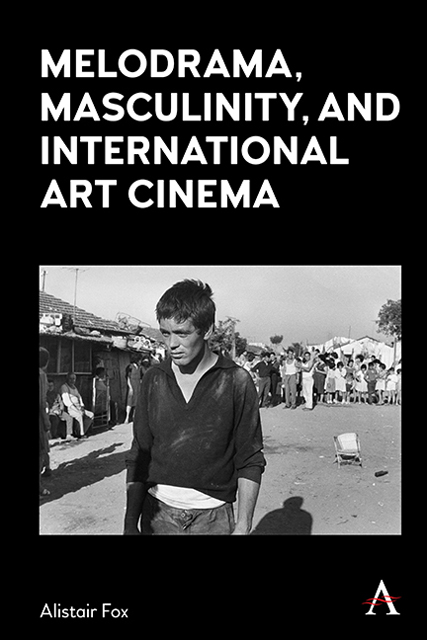Book contents
- Frontmatter
- Dedication
- Contents
- List of Figures
- Preface
- Acknowledgments
- Introduction
- Chapter 1 Italian Neorealism and the Emergence of the Male Melodrama: Vittorio De Sica’s Bicycle Thieves (1948) and Umberto D. (1952)
- Chapter 2 The Migration of Male Melodrama into Non-Western Cultures: Satyajit Ray’s The Apu Trilogy (1955–59) and “Fourth Cinema”
- Chapter 3 Hollywood Melodrama as a Vehicle for Self-Projection: Vincente Minnelli’s Tea and Sympathy (1956) and Home from the Hill (1960)
- Chapter 4 The Political Turns Personal: Neo-Neorealism and Pier Paolo Pasolini’s Accattone (1961)
- Chapter 5 Personal Cinema as Psychodrama: Ingmar Bergman’s Wild Strawberries (1957), Winter Light (1963) and Hour of the Wolf (1968)
- Chapter 6 François Truffaut and the Tyranny of Romantic Obsession: The Soft Skin (1964), Mississippi Mermaid (1969) and The Woman Next Door (1981)
- Chapter 7 Figuring an Authorial Fantasmatic: Jacques Demy’s The Umbrellas of Cherbourg (1964), A Room In Town (1982) and Parking (1985)
- Chapter 8 Rainer Werner Fassbinder and the Emergence of Queer Cinema: The Merchant of Four Seasons (1972), Fox and His Friends (1975) and In a Year with 13 Moons (1978)
- Chapter 9 Visual Aestheticism and the Queer Prestige Melodrama: Call Me by Your Name (2017) and Luca Guadagnino’s Desire Trilogy
- Conclusion
- List of Films Cited
- Select Bibliography
- Index
Chapter 6 - François Truffaut and the Tyranny of Romantic Obsession: The Soft Skin (1964), Mississippi Mermaid (1969) and The Woman Next Door (1981)
Published online by Cambridge University Press: 10 January 2023
- Frontmatter
- Dedication
- Contents
- List of Figures
- Preface
- Acknowledgments
- Introduction
- Chapter 1 Italian Neorealism and the Emergence of the Male Melodrama: Vittorio De Sica’s Bicycle Thieves (1948) and Umberto D. (1952)
- Chapter 2 The Migration of Male Melodrama into Non-Western Cultures: Satyajit Ray’s The Apu Trilogy (1955–59) and “Fourth Cinema”
- Chapter 3 Hollywood Melodrama as a Vehicle for Self-Projection: Vincente Minnelli’s Tea and Sympathy (1956) and Home from the Hill (1960)
- Chapter 4 The Political Turns Personal: Neo-Neorealism and Pier Paolo Pasolini’s Accattone (1961)
- Chapter 5 Personal Cinema as Psychodrama: Ingmar Bergman’s Wild Strawberries (1957), Winter Light (1963) and Hour of the Wolf (1968)
- Chapter 6 François Truffaut and the Tyranny of Romantic Obsession: The Soft Skin (1964), Mississippi Mermaid (1969) and The Woman Next Door (1981)
- Chapter 7 Figuring an Authorial Fantasmatic: Jacques Demy’s The Umbrellas of Cherbourg (1964), A Room In Town (1982) and Parking (1985)
- Chapter 8 Rainer Werner Fassbinder and the Emergence of Queer Cinema: The Merchant of Four Seasons (1972), Fox and His Friends (1975) and In a Year with 13 Moons (1978)
- Chapter 9 Visual Aestheticism and the Queer Prestige Melodrama: Call Me by Your Name (2017) and Luca Guadagnino’s Desire Trilogy
- Conclusion
- List of Films Cited
- Select Bibliography
- Index
Summary
François Truffaut, one of the directors who launched the French New Wave, occupies a special place in the history of the evolution of the male melodrama. By eclectically combining aspects of American cinema, Italian neorealism, and Bergmanesque psychological drama to express his own personal concerns, he developed a mode of filmmaking that, both in terms of its thematic preoccupations and stylistic techniques, has exerted a powerful influence on many filmmakers ever since. This new kind of film was first manifest in his coming-of-age drama The 400 Blows (Les quatre cents coups, 1959), followed by a series of films tracing the ongoing experience of Truffaut’s fictional avatar, Antoine Doinel (acted by Jean-Pierre Léaud): as a young adult in Antoine and Colette (Antoine et Colette, 1962); as a fiançé in Stolen Kisses (Baisers volés, 1968); as a married man in Bed and Board (Domicile conjugal, 1970); and finally as a divorcé in Love on the Run (L’Amour en fuite, 1979).
These films put into practice a manifesto that Truffaut had proclaimed boldly in 1957, while as yet still only an ardent cinephile and film critic:
The film of tomorrow appears to me as even more personal than an individual and autobiographical novel, like a confession or a diary. The young filmmakers will express themselves in the first person and will relate what has happened to them: it may be the story of their first love or their most recent; of their political awakening; the story of a trip, a sickness, their military service, their marriage, their last vacation. And it will be enjoyable because it will be true. The film of tomorrow will be an act of love.
In contrast to “the stereotyped representation of reality that had come to dominate French cinema” in what Truffaut referred to disparagingly as “le cinéma de papa” (Daddy’s cinema), he aimed for a kind of film that was extremely realistic, projecting a personal vision of things that were close to the filmmaker’s own experience. In this regard, he was candid in admitting the formative influence of Roberto Rossellini and Ingmar Bergman.
- Type
- Chapter
- Information
- Melodrama, Masculinity and International Art Cinema , pp. 115 - 136Publisher: Anthem PressPrint publication year: 2022

